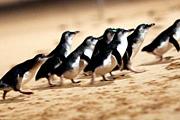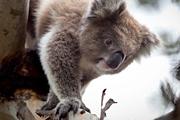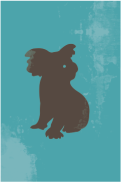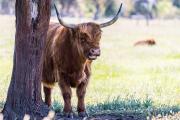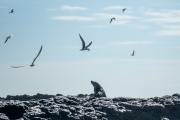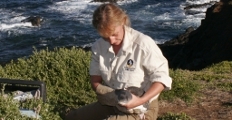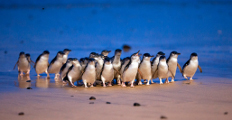Deputy Research Manager
Duncan is a vertebrate population ecologist with expertise in pest animals, wildlife conservation and population modelling. His research focus on the drivers of population change to inform best practise management of wildlife. He is an Honorary Fellow at The University of Melbourne, Member of The Western Port Biosphere Research Committee, Secretary of the Phillip Island Nature Parks Animal Ethics Committee, and past Council Member of the Australian Mammal Society.
Email: dsutherland@penguins.org.au
Phone: + 61 (3) 59512850
Mail: Phillip Island Nature Parks, PO Box 97, Cowes Vic. 3922, Australia
Professional Area
Vertebrate ecology and population modelling
Current projects
- Population dynamics of seabirds
- Nest predation: predators and impacts
- Distribution and abundance of breeding seabirds in Victoria
- Ecotourism and seabird demographics
- Invasive predator impacts, management and eradication
- Mesopredator release and trophic cascades
- Re-establishing faunal diversity and function
- Ecology of macropod populations
Education
2005 - Ph.D. (Ecology), Monash University, Clayton
1998 - Honours (Zoology), Monash University, Clayton
1998 – Bachelor of Arts, Monash University, Clayton
Current students
- Manuela Fischer. Swamp wallabies in a modified landscape: ecology and interactions with humans on Phillip Island (PhD., The University of Melbourne, co-supervised with Julian Di Stefano and Graeme Coulson)
Selected recent publications (see full list in Research Gate)
Sutherland, D. R. and Dann, P. (2014). Population trends in a substantial colony of Little Penguins: three independent measures over three decades. Biodiversity and Conservation 23:241-250.DOI: 10.1007/s10531-013-0597-y
Long-term trends in Little Penguins using a robust survey method reveal a doubling of population size over the last three decades. Trends are consistent with a demographic model, but counts of penguins crossing a major beach access point near the periphery of the colony reveal a different pattern.
Rendall A, White J, Sutherland D R, and Cooke R (2014) Camera trapping: A contemporary approach to monitoring invasive rodents in high conservation priority ecosystems. PLOS ONE 9:e86592
Camera traps yield high detection rates of invasive rodents and pose minimal risks to non-target native wildlife which is especially important in high conservation value areas. Detection rates of black rats and house mice were most associated with vegetation structure rather than proximity to seabird colonies, though activity was high throughout seabird colonies.
Rout T. M., Kirkwood R., Sutherland D. R., Murphy S., McCarthy M.A. (2013) When to declare successful eradication of an invasive predator. Animal Conservation. DOI: 10.1111/acv.12065
Fox abundance has plummeted on Phillip Island since 2006 and describes a robust decision framework revealing we should continue active management of foxes for four years after the last sign of fox presence before declaring successful eradication.
Cruz J., Sutherland D. R., Anderson D. P., Glen A. S., De Tores P. J. & Leung L. K-P. (2013) Antipredator responses of koomal (Trichosurus vulpecula hypoleucus) against introduced and native predator species. Behavioral Ecology and Sociobiology67(8), 1329-1338. DOI: 10.1007/s00265-013-1561-2
Native species like brushtail possums can respond to the threats of introduced foxes and cats, as well as native carnivores, which coexist in the same habitat. Possums move through safer areas in the bush as predator abundances increase.
Sutherland D. R. & Dann P. (2012) Improving accuracy of population size estimates for burrow nesting seabirds. Ibis154(3), 488-498. DOI:10.1111/j.1474-919X.2012.01234.x
We describe a novel method for deriving more accurate population size estimates that employs mark-recapture methods to correct for unknown variation in nest occupancy throughout a little penguin breeding season.
Berry O., Algar D., Angus J., Hamilton N., Hilmer S. & Sutherland D. R. (2012) Genetic tagging reveals a significant impact of poison baiting on an invasive species. Journal of Wildlife Management 76 (4):729–739. DOI:10.1002/jwmg.295
This experiment provides the first quantitative assessment of the effectiveness of 1080 poison baiting for reducing fox density, and in this case demonstrates it to be a highly effective method for culling foxes from a region. Further, it demonstrates that non-invasive DNA analysis will provide significantly more data than conventional trapping methods.
Cruz J., Sutherland D. R., Leung L. K.-P., & Martin G. R. (2012). Are smaller subspecies of common brushtail possums more omnivorous that larger ones? Austral Ecology37(8), 893-902. DOI:10.1111/j.1442-9993.2011.02346.x
Smaller subspecies of common brushtail possums in Australia supplement their diets with larger proportions of non-foliar items. These foods are possibly more susceptible to changes in habitat quality so that smaller subspecies, by being more dependent on them may also be more vulnerable to habitat alteration.
Sutherland D. R., Glen A. S., & de Tores P. J. (2011) Could controlling mammalian carnivores lead to mesopredator release of carnivorous reptiles? Proceedings B, 278, 641-648. DOI:10.1098/rspb.2010.2103.
A meta-analysis showing extensive dietary niche overlap between varanids, foxes and cats plus a review of experimental and circumstantial evidence suggests mesopredator release of six medium to large species of varanid lizard is likely. This highlights the need for managers to adopt a whole-of-community approach when attempting to manage predators for sustained fauna conservation
Sutherland D. R. & Singleton G. R. (2006). Self-regulation within outbreak populations of feral house mice: a test of alternative models. Journal of Animal Ecology75: 584-594. DOI: 10.1111/j.1365-2656.2006.01081.x
Feral house mice that undergo significant fluctuations in density, termed mouse plagues, switch from an almost asocial structure at low densities to a territorial system as abundance increases. Adult females appear more likely than males or juveniles to make the significant social shift.
Sutherland D. R., Spencer P. B. S., Singleton G. R. & Taylor A. C. (2005). Kin interactions and changing social structure during a population outbreak of feral house mice. Molecular Ecology14, 2803-2814. DOI: 10.1111/j.1365-294X.2005.02623.x
The maintenance of female kin groups among feral mice through the preceding winter significantly improves recruitment during the subsequent breeding season, and is therefore necessary for mouse outbreaks.





